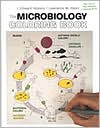Microbiology Coloring Book
This is a book about microorganisms: viruses, bacteria, fungi, protozoans, and multicellular parasites. It is a text on microbiology, and covers basic microbiology, medical microbiology, and some industrial microbiology. It is an unusual text because it offers the student an opportunity to learn by coloring illustrations in a planned and meaningful sequence. The coloring approach opens the subject of microorganisms to high school students, yet college and graduate students will also find the...
Search in google:
This is a book about microorganisms: viruses, bacteria, fungi, protozoans, and multicellular parasites. It is a text on microbiology, and covers basic microbiology, medical microbiology, and some industrial microbiology. It is an unusual text because it offers the student an opportunity to learn by coloring illustrations in a planned and meaningful sequence. The coloring approach opens the subject of microorganisms to high school students, yet college and graduate students will also find the content of this text challenging. A great deal of information can be gained from studying and working properly designed illustrations. "A picture is worth a thousand words." The student who colors the plates of this book will find real satisfaction in understanding the subject matter because it can be visualized. When recall of the material is required, the picture, complete with thoughtfully applied colors, quickly comes to mind. This book is a very important way to learn about a broad spectrum of microorganisms and how they interact with humans. Happy Coloring!
1. Importance of Microbiology to Humans. 2. Early Microscopes. 3. Spontaneous Generation. 4. Germ Theory: Pasteur. 5. Germ Theory: Koch's Postulates. 6. Light Microscopes. 7. Electron Microscope. 8. Measurements. 9. Eukaryotes/Prokaryotes. 10. Spectrum of Microorganisms. 11. Forms of Bacteria. 12. Bacterial Ultrastructure. 13. Staining Bacteria. 14. Bacterial Cell Envelope. 15. Bacterial Spores. 16. Bacterial Nutrition/Cultivation. 17. Bacterial Reproduction. 18. Conditions for Bacterial Growth. 19. Special Culture Techniques. 20. Isolating Bacteria. 21. Bacterial Metabolism I. 22. Photosynthesis. 23. Bacterial Chromosomes. 24. Bacterial Replication. 25. Protein Synthesis: Transcription. 26. Protein Synthesis: Translation. 27. Protein Synthesis: Synthesis. 28. Mutation. 29. Bacterial Transformation. 30. Bacterial Conjugation. 31. Bacterial Transduction. 32. Genetic Engineering. 33. Introduction to Viruses. 34. Viral Replication. 35. Inactivation of Viruses. 36. Antiviral Vaccines and Drugs. 37. Interferon. 38. Retroviruses. 39. Introduction to Fungi. 40. Life Cycle of Rhizopus Stolonifer. 41. Yeasts. 42. Importance of Fungi. 43. Introduction to Protozoa. 44. Paramecium. 45. Importance of Protozoa. 46. Control of Microorganisms with Physical Agents I. 47. Control of Microorganisms with Physical Agents II. 48. 48 Control of Microorganisms with Chemical Agents. 49. Chemotherapeutic Agents. 50. Antibiotics I: Penicillin. 51. Antibiotics II. 52. Antibiotic Susceptibility Test. 53. Transmission of Infectious Disease. 54. Establishment of Disease. 55. Toxins. 56. Nonspecific Resistance to Disease: Mechanical and Chemical Barriers. 57. Nonspecific Resistance to Disease: Phagocytosis and Opsonization. 58. Nonspecific Resistance to Disease: Inflammation. 59. Specific Resistance: Adaptive Immunity. 60. Development and Structure of the Immune System. 61. Specific Resistance: Antigens. 62. Specific Resistance: Cellular Immunity. 63. 63 Specific Resistance: Humoral Immunity. 64. 64 Specific Resistance: Antibodies. 65. Specific Resistance: Antibody-Antigen Reactions. 66. Complement System. 67. Types of Immunity. 68. Monoclonal Antibodies. 69. Complement Fixation Test. 70. Fluorescent Antibody Test. 71. Immunosorbent Test. 72. Neutralization Test. 73. Agglutination Test. 74. Allergy and Anaphylaxis. 75. Thrombocytopenia. 76. Hemolytic Disease of the Newborn. 77. Immune Complex Hypersensitivity. 78. Cell Hypersensitivity. 79. 79 Upper Respiratory Bacterial Infection. 80. Lower Respiratory Bacterial Infection. 81. Food/Waterborne Bacterial Infections. 82. Soil/Arthropod borne Bacterial Infections. 83. Sexual/Contact Bacterial Infections. 84. Viral Diseases of the Skin. 85. Viral Diseases of Abdominal Organs. 86. Viral Disease of Respiratory/Nervous System. 87. Acquired Immunodeficiency Disease. 88. Protozoan Disease: Sleeping Sickness. 89. Protozoan Disease: Toxoplasmosis. 90. Protozoan Disease: Malaria. 91. Other Protozoan Diseases. 92. Fungal Diseases. 93. Life Cycle: Blood Fluke. 94. Life Cycle: Asian Liver Fluke. 95. Life Cycle: Fish Tapeworm. 96. Other Flatworm Diseases. 97. Life Cycle: Pork Roundworm. 98. Other Roundworm Diseases. 99. Microbiology of Foods. 100 Microbiology of Milk. 101. Water Purification. 103. Sewage Treatment. 103. Nitrogen Cycle. 104. Beer Fermentation. 105. Wine Fermentation.








